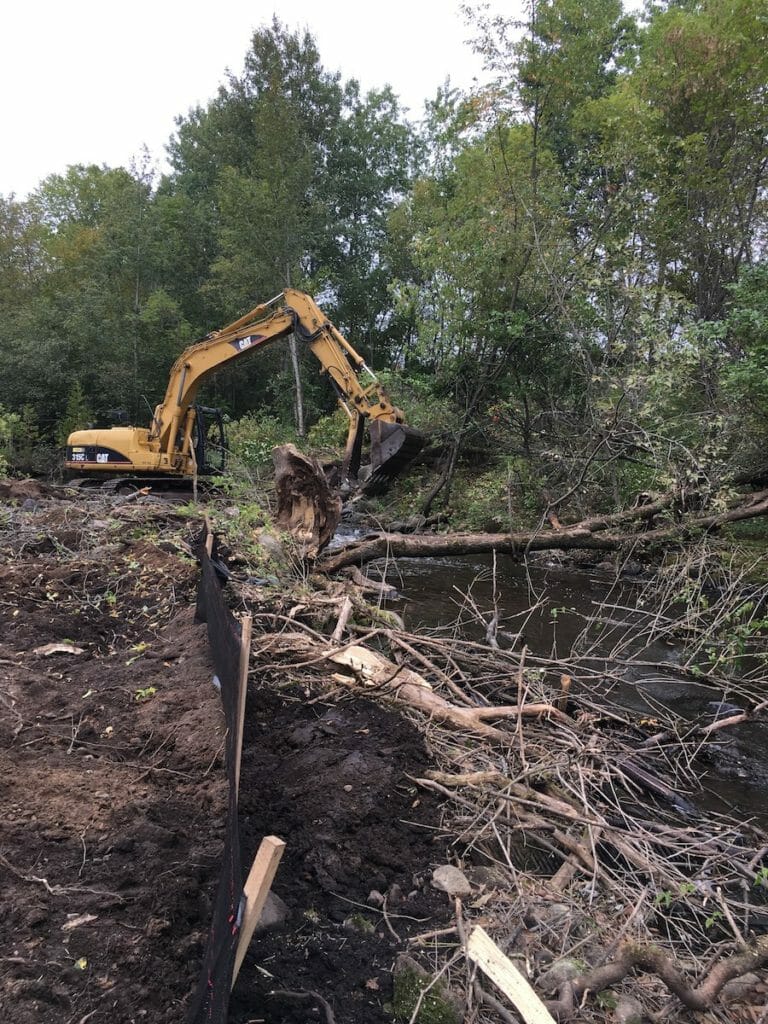A majority of Wisconsin’s 115 fish species, including native brook trout, need to move throughout a watershed seasonally or at varying stages in their lifecycle to feed, find cooler water, avoid predators and reach spawning habitat.
Research conducted in the early 1990s in Northern Wisconsin documented the seasonal movement of trout. When water temperatures reached approximately 60F in the Oconto River in May, trout began migrating up to 30 miles upstream to the South Branch for the summer. The bigger, deeper, warmer water of the Oconto River provided better winter habitat and greater forage, allowing the fish to grow larger. The South Branch provided refuge from the rising temperatures in the summer, as well as better spawning and rearing habitat. This inland migration pattern of trout results in fish that live longer, grow larger, and are more resilient to a changing climate and disease.
However, rivers, long and linear in nature, are vulnerable to habitat fragmentation due in part to our immense network of roads. All too common, where black lines and blue lines meet on a map, aquatic habitat is severed or fragmented preventing fish and other aquatic organisms to move freely. While there are more than 7,000 dams on the rivers, creeks and streams flowing into the Great Lakes, there are over 265,000 road stream crossing – most of them culverts.
The majority of culverts currently in place were designed with the primary objective of moving water under a road. Little consideration was given to the river’s natural hydrology, sediment transport, fish and wildlife, or movement of woody debris. So, it is not too surprising that researchers suspect that 64 percent of culverts in the Great Lakes region may block fish movement. Trout Unlimited has found that replacing a substandard culvert with a fish friendly crossing is often more cost effective and often less controversial than dam removal, enabling us to have a greater impact, faster and cheaper.

The watersheds in and adjacent to the Chequamegon-Nicolet National Forest and their coldwater fisheries are relatively healthy and intact due to limited disturbance. However, barriers that restrict fish from longitudinal movement throughout these watersheds compromise their resiliency and survival.
Trout Unlimited has started a concerted effort to reconnect coldwater habitat in and adjacent to the National Forest. In 2017 and 2018, TU assisted in replacing or removing a total of 11road stream crossings to reconnect over 40 miles of coldwater tributaries, vital spawning and rearing habitat, within the Peshtigo River watershed.
Our approach, based upon the United States Forest Service Stream Simulation Methodology, entails matching the width, elevation and slope of the culvert with that of the natural channel to minimize or eliminate the impact of the road on the stream’s geomorphology. This allows aquatic organisms, silt and the majority of woody debris to pass through the culvert unimpeded. In addition, hydrologic modeling will be applied to ensure that the culvert is large enough to stand up to large flood events.
While Trout Unlimited’s mission is to protect, conserve and restore coldwater habitat, we and our partners believe that our culvert projects go beyond this to benefit our local communities, as well. Like much of our transportation infrastructure, many of culverts are reaching or have exceeded their life expectancy and are in need of replacement. In the event of a failure or imminent failure, municipalities and towns often replace the bad culvert with one of similar dimensions – a missed opportunity to improve the resiliency of both the road infrastructure and the river. Trout Unlimited’s financial contributions and expertise is helping to take the burden off of towns and counties, prevent future catastrophic, life threatening failures and ensure coldwater connectivity. It’s a win-win.
With over 64 percent of culverts posing a potential barrier to aquatic organism passage, prioritization is key to ensure we get the most bang for our buck. In 2016, Trout Unlimited staff and volunteers surveyed and assessed nearly 100 road stream crossings within the Upper Peshtigo River watershed. This dataset will assist in identifying future priority projects as we anticipate this to be an ongoing effort.
Since 2016, TU has assisted the United States Forest Service and local towns in replacing or removing a total of 11 road stream crossings to reconnect over 40 miles of coldwater tributaries, vital spawning and rearing habitat, within the Peshtigo River watershed. An additional 9 culverts are slated for replacement in 2019!
In addition to addressing habitat fragmentation, Trout Unlimited staff and volunteers continue to coordinate with state and federal personnel in the region to improve habitat through collaborative instream improvement projects, such as brush bundling to narrow streams widened by historical land use. Narrow channels are deeper providing overhead cover for trout and insulation from solar heat. This ensures that the headwaters and tributaries we are reconnecting to the mainstems remain thermal refuges and vital spawning/rearing habitats.

